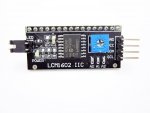//YWROBOT
#include "LiquidCrystal_I2C.h"
#include <inttypes.h>
#include "WProgram.h"
#include "Wire.h"
// When the display powers up, it is configured as follows:
//
// 1. Display clear
// 2. Function set:
// DL = 1; 8-bit interface data
// N = 0; 1-line display
// F = 0; 5x8 dot character font
// 3. Display on/off control:
// D = 0; Display off
// C = 0; Cursor off
// B = 0; Blinking off
// 4. Entry mode set:
// I/D = 1; Increment by 1
// S = 0; No shift
//
// Note, however, that resetting the Arduino doesn't reset the LCD, so we
// can't assume that its in that state when a sketch starts (and the
// LiquidCrystal constructor is called).
LiquidCrystal_I2C::LiquidCrystal_I2C(uint8_t lcd_Addr,uint8_t lcd_cols,uint8_t lcd_rows)
{
_Addr = lcd_Addr;
_cols = lcd_cols;
_rows = lcd_rows;
_backlightval = LCD_NOBACKLIGHT;
}
void LiquidCrystal_I2C::init(){
init_priv();
}
void LiquidCrystal_I2C::init_priv()
{
Wire.begin();
_displayfunction = LCD_4BITMODE | LCD_1LINE | LCD_5x8DOTS;
begin(_cols, _rows);
}
void LiquidCrystal_I2C::begin(uint8_t cols, uint8_t lines, uint8_t dotsize) {
if (lines > 1) {
_displayfunction |= LCD_2LINE;
}
_numlines = lines;
// for some 1 line displays you can select a 10 pixel high font
if ((dotsize != 0) && (lines == 1)) {
_displayfunction |= LCD_5x10DOTS;
}
// SEE PAGE 45/46 FOR INITIALIZATION SPECIFICATION!
// according to datasheet, we need at least 40ms after power rises above 2.7V
// before sending commands. Arduino can turn on way befer 4.5V so we'll wait 50
delayMicroseconds(50000);
// Now we pull both RS and R/W low to begin commands
expanderWrite(_backlightval); // reset expanderand turn backlight off (Bit 8 =1)
delay(1000);
//put the LCD into 4 bit mode
// this is according to the hitachi HD44780 datasheet
// figure 24, pg 46
// we start in 8bit mode, try to set 4 bit mode
write4bits(0x03);
delayMicroseconds(4500); // wait min 4.1ms
// second try
write4bits(0x03);
delayMicroseconds(4500); // wait min 4.1ms
// third go!
write4bits(0x03);
delayMicroseconds(150);
// finally, set to 4-bit interface
write4bits(0x02);
// set # lines, font size, etc.
command(LCD_FUNCTIONSET | _displayfunction);
// turn the display on with no cursor or blinking default
_displaycontrol = LCD_DISPLAYON | LCD_CURSOROFF | LCD_BLINKOFF;
display();
// clear it off
clear();
// Initialize to default text direction (for roman languages)
_displaymode = LCD_ENTRYLEFT | LCD_ENTRYSHIFTDECREMENT;
// set the entry mode
command(LCD_ENTRYMODESET | _displaymode);
home();
}
/********** high level commands, for the user! */
void LiquidCrystal_I2C::clear(){
command(LCD_CLEARDISPLAY);// clear display, set cursor position to zero
delayMicroseconds(2000); // this command takes a long time!
}
void LiquidCrystal_I2C::home(){
command(LCD_RETURNHOME); // set cursor position to zero
delayMicroseconds(2000); // this command takes a long time!
}
void LiquidCrystal_I2C::setCursor(uint8_t col, uint8_t row){
int row_offsets[] = { 0x00, 0x40, 0x14, 0x54 };
if ( row > _numlines ) {
row = _numlines-1; // we count rows starting w/0
}
command(LCD_SETDDRAMADDR | (col + row_offsets[row]));
}
// Turn the display on/off (quickly)
void LiquidCrystal_I2C::noDisplay() {
_displaycontrol &= ~LCD_DISPLAYON;
command(LCD_DISPLAYCONTROL | _displaycontrol);
}
void LiquidCrystal_I2C::display() {
_displaycontrol |= LCD_DISPLAYON;
command(LCD_DISPLAYCONTROL | _displaycontrol);
}
// Turns the underline cursor on/off
void LiquidCrystal_I2C::noCursor() {
_displaycontrol &= ~LCD_CURSORON;
command(LCD_DISPLAYCONTROL | _displaycontrol);
}
void LiquidCrystal_I2C::cursor() {
_displaycontrol |= LCD_CURSORON;
command(LCD_DISPLAYCONTROL | _displaycontrol);
}
// Turn on and off the blinking cursor
void LiquidCrystal_I2C::noBlink() {
_displaycontrol &= ~LCD_BLINKON;
command(LCD_DISPLAYCONTROL | _displaycontrol);
}
void LiquidCrystal_I2C::blink() {
_displaycontrol |= LCD_BLINKON;
command(LCD_DISPLAYCONTROL | _displaycontrol);
}
// These commands scroll the display without changing the RAM
void LiquidCrystal_I2C::scrollDisplayLeft(void) {
command(LCD_CURSORSHIFT | LCD_DISPLAYMOVE | LCD_MOVELEFT);
}
void LiquidCrystal_I2C::scrollDisplayRight(void) {
command(LCD_CURSORSHIFT | LCD_DISPLAYMOVE | LCD_MOVERIGHT);
}
// This is for text that flows Left to Right
void LiquidCrystal_I2C::leftToRight(void) {
_displaymode |= LCD_ENTRYLEFT;
command(LCD_ENTRYMODESET | _displaymode);
}
// This is for text that flows Right to Left
void LiquidCrystal_I2C::rightToLeft(void) {
_displaymode &= ~LCD_ENTRYLEFT;
command(LCD_ENTRYMODESET | _displaymode);
}
// This will 'right justify' text from the cursor
void LiquidCrystal_I2C::autoscroll(void) {
_displaymode |= LCD_ENTRYSHIFTINCREMENT;
command(LCD_ENTRYMODESET | _displaymode);
}
// This will 'left justify' text from the cursor
void LiquidCrystal_I2C::noAutoscroll(void) {
_displaymode &= ~LCD_ENTRYSHIFTINCREMENT;
command(LCD_ENTRYMODESET | _displaymode);
}
// Allows us to fill the first 8 CGRAM locations
// with custom characters
void LiquidCrystal_I2C::createChar(uint8_t location, uint8_t charmap[]) {
location &= 0x7; // we only have 8 locations 0-7
command(LCD_SETCGRAMADDR | (location << 3));
for (int i=0; i<8; i++) {
write(charmap[i]);
}
}
// Turn the (optional) backlight off/on
void LiquidCrystal_I2C::noBacklight(void) {
_backlightval=LCD_NOBACKLIGHT;
expanderWrite(0);
}
void LiquidCrystal_I2C::backlight(void) {
_backlightval=LCD_BACKLIGHT;
expanderWrite(0);
}
/*********** mid level commands, for sending data/cmds */
inline void LiquidCrystal_I2C::command(uint8_t value) {
send(value, 0);
}
inline void LiquidCrystal_I2C::write(uint8_t value) {
send(value, Rs);
}
[B]/************ low level data pushing commands **********/
// write either command or data
void LiquidCrystal_I2C::send(uint8_t value, uint8_t mode) {
uint8_t highnib=value&0xf0;
uint8_t lownib=(value<<4)&0xf0;
write4bits((highnib)|mode);
write4bits((lownib)|mode);
}
void LiquidCrystal_I2C::write4bits(uint8_t value) {
expanderWrite(value);
pulseEnable(value);
}
void LiquidCrystal_I2C::expanderWrite(uint8_t _data){
Wire.beginTransmission(_Addr);
Wire.send((int)(_data) | _backlightval);
Wire.endTransmission();
}
void LiquidCrystal_I2C::pulseEnable(uint8_t _data){
expanderWrite(_data | En); // En high
delayMicroseconds(1); // enable pulse must be >450ns
expanderWrite(_data & ~En); // En low
delayMicroseconds(50); // commands need > 37us to settle
} [/B]
// Alias functions
void LiquidCrystal_I2C::cursor_on(){
cursor();
}
void LiquidCrystal_I2C::cursor_off(){
noCursor();
}
void LiquidCrystal_I2C::blink_on(){
blink();
}
void LiquidCrystal_I2C::blink_off(){
noBlink();
}
void LiquidCrystal_I2C::load_custom_character(uint8_t char_num, uint8_t *rows){
createChar(char_num, rows);
}
void LiquidCrystal_I2C::setBacklight(uint8_t new_val){
if(new_val){
backlight(); // turn backlight on
}else{
noBacklight(); // turn backlight off
}
}
void LiquidCrystal_I2C::printstr(const char c[]){
//This function is not identical to the function used for "real" I2C displays
//it's here so the user sketch doesn't have to be changed
print(c);
}
// unsupported API functions
void LiquidCrystal_I2C::off(){}
void LiquidCrystal_I2C::on(){}
void LiquidCrystal_I2C::setDelay (int cmdDelay,int charDelay) {}
uint8_t LiquidCrystal_I2C::status(){return 0;}
uint8_t LiquidCrystal_I2C::keypad (){return 0;}
uint8_t LiquidCrystal_I2C::init_bargraph(uint8_t graphtype){return 0;}
void LiquidCrystal_I2C::draw_horizontal_graph(uint8_t row, uint8_t column, uint8_t len, uint8_t pixel_col_end){}
void LiquidCrystal_I2C::draw_vertical_graph(uint8_t row, uint8_t column, uint8_t len, uint8_t pixel_row_end){}
void LiquidCrystal_I2C::setContrast(uint8_t new_val){}


